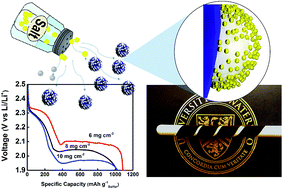Compact high volumetric and areal capacity lithium sulfur batteries through rock salt induced nano-architectured sulfur hosts†
Abstract
Tremendous efforts have been put into designing high gravimetric energy density lithium sulfur batteries (LIS) through increasing the areal sulfur loading in the cathode, however little to no attention has been paid to the volumetric energy density of LIS. Due to the low tap density of porous carbon as a common sulfur host, an excessively high electrode thickness per sulfur loading severely decreases the volumetric energy density to the point of little practical use. For the first time, a sulfur host with an engineered polymodal particle size distribution was utilized for compact high areal capacity sulfur electrodes. This material demonstrated the highest reported blade cast volumetric capacity of 495 mA h cm−3 at 5.4 mA h cm−2 while remaining true to traditional blade casting battery manufacturing processes. It demonstrated superior electrochemical activity at 0.1C by delivering capacities of 1010 mA h g−1 at 10.2 mg cm−2 and 1350 mA h g−1 at 4 mg cm−2 with good stability. Furthermore, even with its thin electrode profile of 86 μm at 4 mg cm−2 capacities of 1103 mA h g−1 and 972 mA h g−1 at 0.2C and 0.5C were achieved, respectively.



 Please wait while we load your content...
Please wait while we load your content...